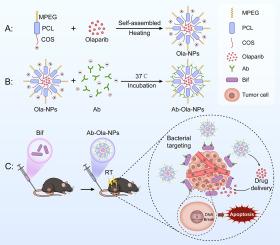Radiosensitizing effects of olaparib nanoparticles modified by Bifidobacterium antibodies on lung cancer
IF 5.1
3区 工程技术
Q1 CHEMISTRY, APPLIED
引用次数: 0
Abstract
Local hypoxia within solid tumors significantly impedes therapeutic efficacy. Hypoxia-targeted therapies have emerged as powerful strategies to overcome treatment resistance. This study exploits the ability of Bifidobacterium infantis (Bif) to actively colonize hypoxic tumor regions, in conjunction with the radiosensitizing properties of the PARP inhibitor olaparib (Ola). This study developed MPEG-PCL-COS (Methoxy Polyethylene Glycol-Polycaprolactone-Chitosan Oligosaccharide) nanocarriers for the preparation of Ola nanoparticles (Ola-NPs) and Ola-NPs modified with bifidobacterium-specific antibodies (Ab-Ola-NPs). This method facilitates the targeted delivery of nanoparticles to lung cancer cells, resulting in improved therapeutic outcomes when combined with radiotherapy (RT). The experimental results indicate that Ola-NPs exhibit a superior in vivo sensitization enhancement ratio (SER) of 4. The active targeting capability of Ab-Ola-NPs significantly inhibits lung cancer tumor growth and extends the survival time of mice to 42 days. The enhanced therapeutic effect is attributed to the radiosensitizing properties of Ola-NPs in targeting hypoxic tumor regions, with mechanisms involving apoptosis, cell proliferation, and DNA damage.

双歧杆菌抗体修饰的奥拉帕尼纳米颗粒对肺癌的放射增敏作用
实体瘤内局部缺氧严重影响治疗效果。低氧靶向治疗已成为克服治疗耐药性的有力策略。这项研究利用了婴儿双歧杆菌(Bifidobacterium婴儿双歧杆菌)在缺氧肿瘤区域积极定植的能力,以及PARP抑制剂奥拉帕尼(olaparib, Ola)的放射增敏特性。本研究开发了MPEG-PCL-COS(甲氧基聚乙二醇-聚己内酯-壳聚糖低聚糖)纳米载体,用于制备Ola纳米粒子(Ola- nps)和双歧杆菌特异性抗体修饰的Ola- nps。这种方法有助于将纳米颗粒靶向递送到肺癌细胞,当与放疗(RT)联合使用时,可以改善治疗效果。实验结果表明,Ola-NPs的体内增敏增强比(SER)为4。Ab-Ola-NPs的主动靶向能力显著抑制肺癌肿瘤生长,使小鼠存活时间延长至42天。这种增强的治疗效果归因于Ola-NPs靶向低氧肿瘤区域的放射增敏特性,其机制涉及凋亡、细胞增殖和DNA损伤。
本文章由计算机程序翻译,如有差异,请以英文原文为准。
求助全文
约1分钟内获得全文
求助全文
来源期刊

Reactive & Functional Polymers
工程技术-高分子科学
CiteScore
8.90
自引率
5.90%
发文量
259
审稿时长
27 days
期刊介绍:
Reactive & Functional Polymers provides a forum to disseminate original ideas, concepts and developments in the science and technology of polymers with functional groups, which impart specific chemical reactivity or physical, chemical, structural, biological, and pharmacological functionality. The scope covers organic polymers, acting for instance as reagents, catalysts, templates, ion-exchangers, selective sorbents, chelating or antimicrobial agents, drug carriers, sensors, membranes, and hydrogels. This also includes reactive cross-linkable prepolymers and high-performance thermosetting polymers, natural or degradable polymers, conducting polymers, and porous polymers.
Original research articles must contain thorough molecular and material characterization data on synthesis of the above polymers in combination with their applications. Applications include but are not limited to catalysis, water or effluent treatment, separations and recovery, electronics and information storage, energy conversion, encapsulation, or adhesion.
 求助内容:
求助内容: 应助结果提醒方式:
应助结果提醒方式:


